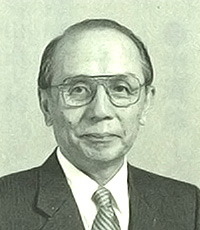Japanese Pioneers
Yasuo Tarui

Yasuo Tarui was born in 1929. After graduating from the electrical engineering department in the First Faculty of Science and Engineering at Waseda University in 1951, he went to work for the Electrotechnical Laboratory of the Agency of Industrial Science and Technology. He was appointed chief of the semiconductor components laboratory of the Electrotechnical Laboratory in 1965 and director of the cooperative laboratory of the VLSI Technology Research Association in 1976. In 1981, he became a professor in the electrical engineering department at the Tokyo University of Agriculture and Technology. He took up Waseda University’s offer of a visiting professorship at one of their graduate schools in 1993. He was awarded the Medal with Purple Ribbon in 1995. He became an executive director of the Takeda Foundation in 2001.
Having taken part in research into transistors since its beginnings, Tarui was a pioneer in the field of integration technology and made significant contributions to the development of integrated circuits from ICs, through LSI circuits, to VLSI circuits. It was on January 21, 1961 that he completed the first IC in Japan. His participation in the Super High-Performance Computer Development Project led to the invention of electron-beam exposure equipment in 1968, Schottky TTL in 1969, and the world’s first announcement of a DSAMOS transistor in 1970. Also under this project, he assigned the production of 144-bit SRAM using NMOS transistors to Nippon Electric Company and that of hybrid LSI circuits to Hitachi. He became director of the cooperative laboratory of the VLSI Technology Research Association when this started in 1976, there establishing VLSI process technologies over a four-year development period and opening the way to submicron processes, and securing the subsequent prosperity of the Japanese semiconductor industry.
The Institute of Telecommunications Engineers gave him the Waseda Award in 1953, the Achievement Award in 1970, and the Thesis Award in 1978. Among other prizes, he was also given a Chairman of the Federations of Economic Organizations Award (the National Commendation for Invention) in 1977, the SSDM (Solid State Devices and Materials) Award in 1990, the C & C Award in 1991, and the Medal with Purple Ribbon in 1995. His well-known books include Semiconductor Devices and The Story of ICs.


